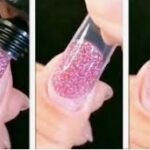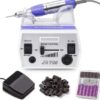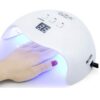Acrylic nails are very popular among nail enthusiasts, however, since the introduction of polygel manicure, the smooth application made it an instant hit. But which one is better than the other? We already know polygel is lightweight; what else does it offer? Does it offer such a wide range of variety and options of experimentation like an acrylic manicure? Let’s find out in this article.

Primary Difference: Polygel Vs. Acrylic
Polygel and acrylics have two primary points in common. Polygel enhancements, like acrylic, don’t usually need to be removed; instead, you can quickly fill in the nail growth region with more Polygel. Second, Polygel nails, like acrylic, may be put over a nail form and molded to produce a nail extension. Polygel nails contrast with acrylic nails in various aspects, and Polygel nails tend to surpass artificial manicures for these reasons. It possesses acrylic strength but is lightweight, stronger, and more elastic. Polygel fingernails are less prone to break as a result of this. Polygel is also easier to apply since it eliminates lengthy powder mixing.
Application Ease: Are Polygel Nails Easier Than Acrylic?
Application
Acrylic fingernails are nail extensions, whereas Polygel is similar to nail polish. Acrylic nails require an adhesive to adhere to the natural nail, whereas Polygel requires the use of UV light to cure. You can purchase acrylics as a paste. Liquid monomer and powder monomer are combined to make the paste. After that, the paste is placed on the nails and molded into the desired form and size. Acrylic nails offer a flat surface on which to apply nail art. Polygel, on the other hand, comes in the shape of a gel. Acrylic powder is mixed to make the gel. The paste is cured beneath UV light after application. The gel serves as a foundation layer, and two further layers, polish and top layer, are applied on top of it. It’s a new trend that’s lightweight, easy to apply, and remove.
Curing Time
Polygel takes roughly 30 seconds to cure in an LED bulb and two minutes under a UV lamp. On the other hand, acrylic nails do not require the use of a UV light to dry. Instead, when the polymer and monomer are combined, they will chemically react and spontaneously harden once exposed to air. Acrylic paint takes roughly 10-15 minutes to dry.
Removal
The procedure of removing artificial nails takes a long time. To make removal easier, soak the nails with acetone. Natural nails can become brittle and dry when exposed to acetone. The extension glue may cause damage to the native nail’s covering. Polygel is simple to use and take off. All of the gels would be removed by just brushing them off. It’s lighter than most other manicures, yet it lasts just as long on the nails.
Filling In The Nails
You’ll need to clean the previous nail paint coats until you fill in the acrylic nails. Clean your fingernails with a wipe once you’ve removed the nail paint. Before you can start filling the gaps, you’ll need a clean surface. Because you’ll be filling the gap with acrylic later, you’ll need to eliminate the lifts for a flawless acrylic nail finish. Remove any bumps using a buffer and strive to obtain a smooth base as much as possible. Apply the little ball of paste to your fingers and distribute it around your natural nail as well as the artificial nail. Use your nail file or a buffer to the acrylic layer you’ve just finished applying. Apply one to two coats of nail paint on your nails and let these dry, and the filling process will be complete.
Polygel, on the other hand, seldom needs to be removed; instead, the nail growth region may be filled in with more Polygel. The Polygel stays on the fingernail and is filed down during a fill-in. Then, near the cuticle, additional Polygel is used to fill up the region where the fingernail has steadily grown. The Polygel is patted down with a brush soaked in a slip solution. For 30 to 60 seconds, the nails are cured. A gel topcoat is applied after the nails have been shaped, buffed, cleansed, and cured again. Finally, a wipe saturated in nail surface cleaner is used to wipe the nails once more. This concludes the procedure!
Longevity: Are Polygel Nails Stronger Than Acrylic?
Manicures made with Polygel can endure for three to four weeks. The duration of your Polygel manicure, as well as your lifestyle, will determine how long it lasts. When a light nude or pink manicure has grown out, it isn’t easy to detect, so it lasts much longer than you may imagine. Acrylic nails, in contrast, can persist for several months. It is also contingent on you and how well you care for them. You may make your acrylic fingernails last as long as your nails can comfortably wear them if you’re ready to put effort and time; however, you may need to fill them regularly.
Maintenance Ease: Polygel Vs. Acrylic
When it comes to acrylics aftercare, the key point to remember is to be gentle with them. To open cans or pry items open, lift something heavy, break tapes, etc., avoid using your nails. When caring for your acrylic nails, another crucial guideline to remember is to keep the nails dry. It’s also important to look after the skin surrounding your nails. Handwashing using antibacterial soap frequently will lower your chances of contracting an infection.
Treat your nails carefully, wear gloves when doing chores, apply cuticle moisturizers, and so on if you have Polygel! Avoid exposing your nails to severe circumstances such as cooking heat, cleaning with strong detergents, and gardening with pesticides. These circumstances tend to wear down your Polygel nails, causing them to fade and lift more efficiently.
Price Comparison: Are Polygel Nails More Expensive Than Acrylic?
The cost of Polygel nails depends on the method of application. A complete set or sculpted extension treatment can cost anything from $55 to $150, although a fill-in usually costs little more than $80. In addition, Polygel at-home nail kits may cost anywhere from $25 to $50. Whereas, a mid-range acrylic manicure in a spa or salon can cost anywhere from $35 to $45 for a standard set. This price can rise to $50 or $60 for hues like pink or white. In addition, acrylic at-home nail kits can range anywhere from $10 to $75.
Safety Concerns: Are Polygel Nails Safer Than Acrylic?
Acrylic nail polish has the potential to harm the nails. Acrylic nails must be dipped in acetone and then polished off, which might take some time. Not only can acetone make your fingernails dry and fragile, but the polishing procedure can also weaken them. Acrylic nails are much heavier than Polygel nails. It also has a considerably milder scent, which is ideal for those who prefer the appearance of acrylics but not the smell! The polish is rubbed off rather than soaking off while removing Polygel nails. They are entirely safe for your nails if placed and removed correctly. Because no chemicals are discharged into the air during the application of Polygel, it may be considered safer than acrylics.
Final Verdict
Both nail care approaches have unique distinctions and various methods of application and removal. Acrylic nails have been in the manicure world for a long time; however, Polygel is a relatively recent technology that has gained popularity due to its benefits. Polygel manicures are superior to artificial nails for various reasons, and they are significantly safer in the long term.








